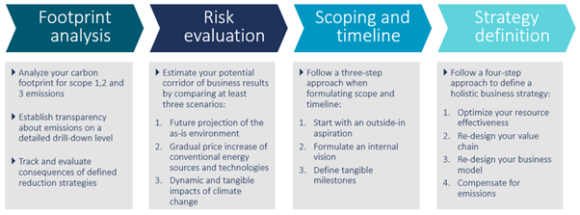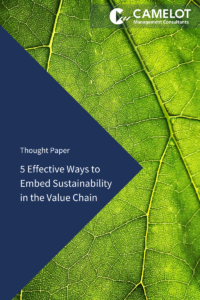The pressure on companies to become more sustainable is constantly increasing. Organizations need to define carbon reduction targets now and make the right decarbonization decisions in their individual business environment. A structured approach helps to formulate a viable path to climate-neutral.
Five years ago, the Paris Agreement set the political basis for international climate protection. Today, an evolving number of stakeholders are putting pressure on organizations to act more sustainably: from consumers demanding greener products, over political institutions setting minimum sustainability requirements, up to investors who integrate sustainability principles into their investment decisions. In fact, environmental principles are one of the main priorities of most global institutional investment firms, including the world’s three biggest asset managers.[1]
Therefore, in the past years, leaders across all industries have been announcing carbon reduction targets. These targets vary widely in terms of emission scope (1, 2 or 3), reference year, time frame, and target reduction value. By analyzing Dow Jones and EuroStoxx50 companies, we identified that approximately 70% of all organizations are transparent about their Scope 1, 2 and 3 emissions and more than 50% have defined a carbon reduction goal. However, the reference year of this carbon reduction varies widely and is often not transparent. There are three different groups within the companies that announced a target:
- The “mainstream” group accounting for almost 50% of the companies announced a carbon reduction goal until 2035 with a maximum reduction potential of 50 %.
- The “front-runner” group accounting for around 25% is planning to become (almost) carbon neutral within the next 15 years.
- The “long distance” group accounting for around 25% is announcing carbon neutrality goals for the years 2040-2050.
Most of the leading organizations’ carbon targets are oriented towards the GHG-protocol. Reflecting the challenges of tracking down carbon emissions across external partners along the value chain, the publication of scope 3 emissions is voluntary . However, more and more companies are deciding to go beyond legal obligations for carbon reporting and submit their emission data and activities to the Carbon Disclosure Project (CDP) as a neutral agency.
Getting your carbon reduction strategy right
The high diversity of carbon reduction targets calls for a best-practice approach of how to set carbon reduction targets. Figure 1 illustrates a structured approach on how to formulate a decarbonization strategy.
Fig. 1: Framework for setting decarbonization targets
Footprint analysis
As we argued in our previous article, transparency on the CO2 footprint is the key prerequisite for sustainable decision making. This – more than ever – also applies to the setting of decarbonization goals. It is important to review the footprint information on a sufficiently detailed drill-down level, such as business unit, value chain step, and country. Only by clearly assigning emissions to business units or functional areas, it is possible to define actions and estimate the effectiveness of carbon reduction measures.
Risk evaluation
When it comes to decarbonization and how to apply it, organizations are facing various types of uncertainties and risks due to policy, legal, technology or market changes that occur as a result of societal efforts to mitigate and adapt to climate change.[2] Examples of these risks are evolving policy frameworks, changes in costs of conventional vs. green energy sources, or carbon price uncertainty. Additionally, organizations are exposed to increasing incidents of natural disasters (droughts, fires, floods or hurricanes) and as a result, to implications such as political instability or migration.
Organizations need to avoid anchoring too much in their current environment and rather acknowledge these uncertainties. To estimate a potential corridor of business results, we recommend calculating at least the following three scenarios:
- Projection of the as-is environment into the future
- Extrapolations of current climate-related trends, e.g. gradual price increase of conventional energy sources and production technologies
- Dynamic and multi-point impacts of climate change (e.g. implications on raw material supply)
Scoping and timeline
The Paris Agreement aims at keeping the increase in global average temperature well below 2°C and to ideally limit it to 1.5°C.[3] Decarbonizing in line with the 2°C pathway requires halving the current emissions by 2030 and reaching net zero emissions by latest 2050.[4] Targets that are in line with this level of decarbonization are considered as “science-based”.[5] The Science Based Target initiative provides a framework for organizations to develop their own carbon reduction target meeting certain criteria. These include clear requirements on the base and target year and – among many others – the obligation to formulate a scope 3 emission reduction target, if they contribute to more than 40% of overall carbon emissions.[6] Via a Sectoral Decarbonization Approach (SDA), the 2°C carbon budget is allocated to different sectors, as for example power generation or rail transport, taking into account the inherent differences (e.g. mitigation potential).[7]
We recommend organizations to follow a three-step approach when formulating their target:
- Start with an outside-in aspiration by orientating your path to climate neutral towards the individual ambition levels formulated by the Science Based Target initiative. Also, include specific national requirements, the behavior of your industry peers and your own maturity.
- Formulate an internal vision for a climate-neutral future of your organization and understand different degrees of measures. Identify quick wins, larger investments and conduct a gap analysis.
- Define tangible milestones for shorter horizons to keep your employees engaged.
Carbon reduction strategy
Organizations want to transition towards a business model that is still viable under a net-zero carbon economy. The transition should be designed as effective as possible and should reflect the targeted decarbonization path. This requires a multi-dimensional strategy: From some smaller improvements of the current supply chain, over a fundamental value chain re-design, up to new business models. It always needs to be evaluated where to invest the next Dollar to be most efficient in terms of decarbonization while maintaining the competitiveness and health of the company. Therefore, we recommend following a four-step approach:
- Optimize resource effectiveness and invest in renewable energies
Decrease your emissions per output quantity by analyzing to which extent current facilities and processes can be made more sustainable through efficiency measures (as e.g. insulation, reduction of energy usage) circular use of e.g. waste or by-products, or investment in renewable energies and breakthrough technologies. - Re-design value chain
Reach a fundamentally higher sustainability level by identifying the parts of your value chain that have the largest carbon contribution and reduction potential, and define mitigation measures (e.g. re-shoring instead of off-shoring or moving to green energy sources such as biogas or hydrogen). - Re-design business model
To become carbon-neutral, step 1 and 2 might often not be enough. Instead, organizations need to overcome existing boundaries and think in green and circular business models. For this, the following questions need to be addressed: How can I make my customers more sustainable? How can I re-invent my products in a more sustainable way? Are new transaction models possible (e.g. renting instead of buying)? Can I extend the life-cycle of my materials and products? - Compensate for emissions
If all effective means for a carbon reduction of an organization are exhausted, it might be more cost-effective to support the decarbonization outside one’s organization by investing into carbon credits. A carbon credit is a tradable certificate representing the right to emit greenhouse gases[8]. In compensation, projects are funded that remove carbon from the atmosphere or avoid greenhouse gas emissions.
Clearly, a credible carbon reduction strategy is a long-term strategy and should be based on a holistic approach covering steps 1, 2 and 3. Relying too much on carbon credits increases the risk of operational, technological or capital lock-in in high-carbon assets that may be unviable in the long term.[9] It would only postpone a transformation an organization needs to undertake in the upcoming years. Therefore, we recommend organizations to firstly invest into a robust climate impact reduction strategy before binding capital on annual carbon credits.
To successfully follow a carbon reduction strategy, sustainability needs to be embedded into the organization via designated roles, a defined governance and reporting framework and a clear internal and external communication. We will address these topics in a subsequent article.
Conclusion
The backbone of a credible carbon reduction strategy is a well-founded and validated carbon reduction target. To be able to formulate this target, footprint and carbon risk factor transparency needs to be achieved. The Sectoral Decarbonization Approach supports organizations in benchmarking their ambition of decarbonization depending on the industry sectors. A carbon reduction strategy needs to be challenged and designed most efficiently from a business point of view. For this, efficiency and supply chain re-design measures must be supplemented by green and circular business models in the long-run.
[1] Harvard Business Review: The Investor Revolution, https://hbr.org/2019/05/the-investor-revolution
[2] CDP, Towards a science-based approach to climate neutrality in the corporate sector, September 2019
[3] https://unfccc.int/process-and-meetings/the-paris-agreement/the-paris-agreement
[4] CDP, Towards a science-based approach to climate neutrality in the corporate sector, September 2019
[6] https://sciencebasedtargets.org/wp-content/uploads/2019/03/SBTi-criteria.pdf
[8] Collins English Dictionary. Retrieved August 18, 2020 from CollinsDictionary.com
[9] CDP, Towards a science-based approach to climate neutrality in the corporate sector, September 2019
We would like to thank Florian Kreitz for his valuable contribution to this article.


